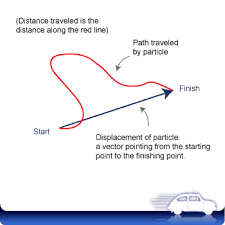GRAPHICAL REPRESENTATION OF DISPLACEMENT AND DISTANCE TRAVELLED
Hi Friends here we come again with the previous point that is related to Motion. In previous Post we have talk about Motion where we have dealt with some points so now lets continue from there...
GRAPHICAL REPRESENTATION OF DISPLACEMENT AND DISTANCE TRAVELLED
The difference between the distance travelled by a body and its displacement is shown graphically in given below
What is meant by positive, negative or zero displacement
The displacement of a body in any direction is given by,
The final position and the initial position are described either relative to each other or to a fixed reference point.
Depending upon the locations of the initial and the final position, the displacement may be negative or positive.
- When x2 is greater than x1, i.e, x2 > x1 , then
d = (x2 – x1) = Positive
i.e, the displacement of the body is positive. Thus,
The displacement of a body is positive if its final position lies on the right of its initial position its initial position on the yy’ –axis.
- When x2 is less than x1, i.e, x2 < x1 , then
d = (x2 – x1) = Negative
i.e, the displacement of the body is negative. Thus,
The displacement of a body is negative if its final position is on the left of its initial position on the x x’ or below its initial position on the y y’ –axis.
- When x2 is equal to x1, I.e., x2 = x1, then
d = (x2 – x1) = 0
i.e., the displacement of the body is zero. This means that initial and the final positions of the body are the same, i.e., the body returns to its initial position.
Thank you(Sashi Kant)



Comments
Post a Comment